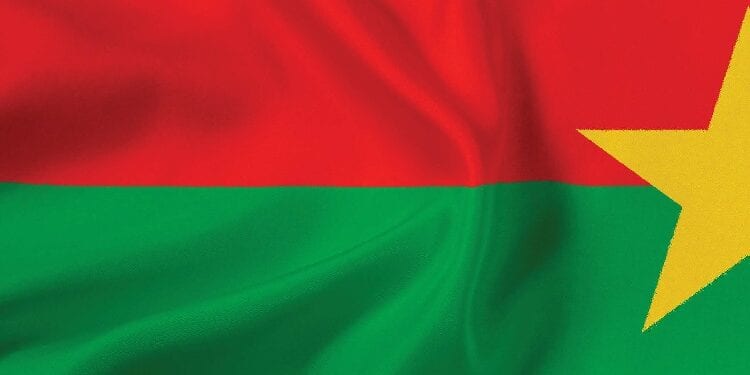Despite the run up in the share prices of general gold equities, I have noticed that the valuation of gold equities within projects located in Burkina Faso remains at relatively low levels. However, with threats come opportunities. Those who believe that gold will be in a long-term bull run may find that companies who offer the cheapest valuations due to market unjustified bias may have the largest leverage over the gold price in the long run.
According to the GFMS, Refinitiv, in 2019 Burkina Faso was the world’s 22nd largest gold producer (down four spots from the previous year) and produced 48 tons of gold. It was also the fifth largest gold-producing nation in Africa. Its gold production has increased by a compound rate of 23.1 percent in the last decade, which is pretty amazing considering that just a decade ago, Burkina Faso did not have a single modern commercial-scale gold mine.
Despite Burkina Faso ramping up its gold production and possibly surpassing Mali to become the fourth largest gold producer in Africa in the near future, investors have reason to remain cautious about investment in the country.
The Risks of Working in Burkina Faso
In recent years, terrorism has become one of the major obstacles to working in many African countries, including Burkina Faso. Since December 2018, there has been a spike in terrorist activity in the country; over a two-month period, there were eight terror attacks resulting in the deaths of over thirty people. In response to the attacks, the Burkina Faso government declared a state of emergency in several northern provinces. Eventually the weight of the terrorist attacks led to the resignation of Prime Minister Paul Thieba.
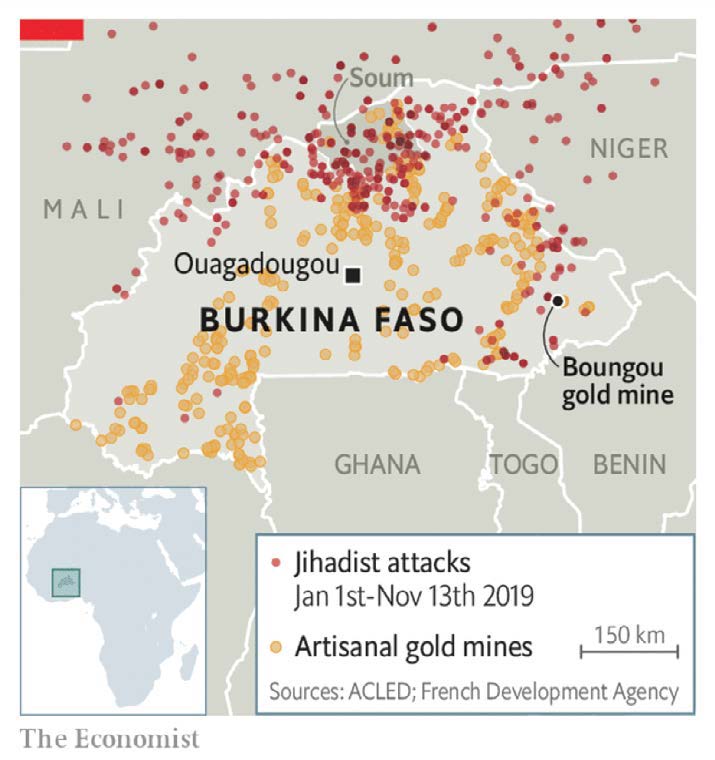
According to data from Armed Conflict Location & Event (ACLED), the number of fatalities due to armed conflicts reported in Burkina Faso reached 1,064 in the first half of 2019, compared to 306 for the whole of 2018. The worst hit region was Sahel (more specifically, the Soum province) in the north, where 607 fatalities were reported in the first half. As a result, most of the northern region, as well as some parts in the east of Burkina Faso, are now considered areas vulnerable to terrorist attacks.
The government has declared that fighting terrorism is a national priority, and thus has been placing more security forces throughout the country and creating specialized task forces. They have also joined forces with other African countries, as well as some Western countries. Most of the past terrorist attacks have not been plotted against gold mines specifically, but in some of the attacks, mining staff got trapped in the middle near their site. Mining companies hire private guards on mine sites and, while they are not allowed to be armed, they should still be able to increase the safety of staff and mine operations.
While agriculture is Burkina Faso’s largest sector, mining is also an important industry to the country’s economy, and the government is expecting that the mining sector’s contribution to the country’s GDP could be more than 10 percent in 2020, compared to 8.3 percent in 2016. As a result, Refinitiv anticipates that the Burkina Faso government will step up its efforts to protect the operations of the country’s gold mines as well as its tax revenue.
The Gold Mining Landscape in Burkina Faso
Currently, there are nine operating mines in Burkina Faso: Taparko-Bouroum, Essakane, Mana, Youga, Hounde, Bissa-Zandkom, Kama, Yaramoko, and the Wahgnion mine where production has just kicked off.
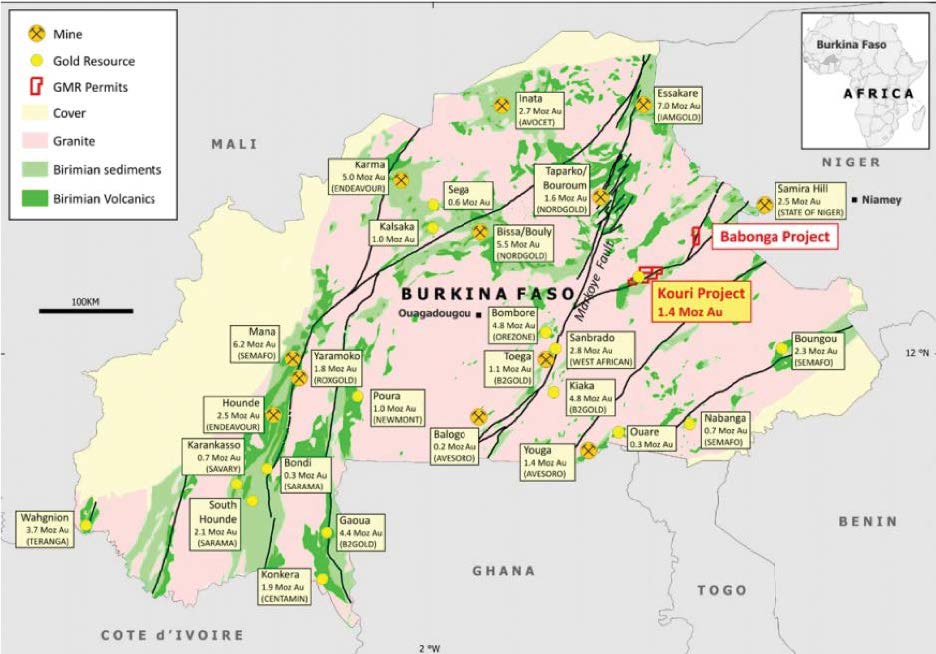
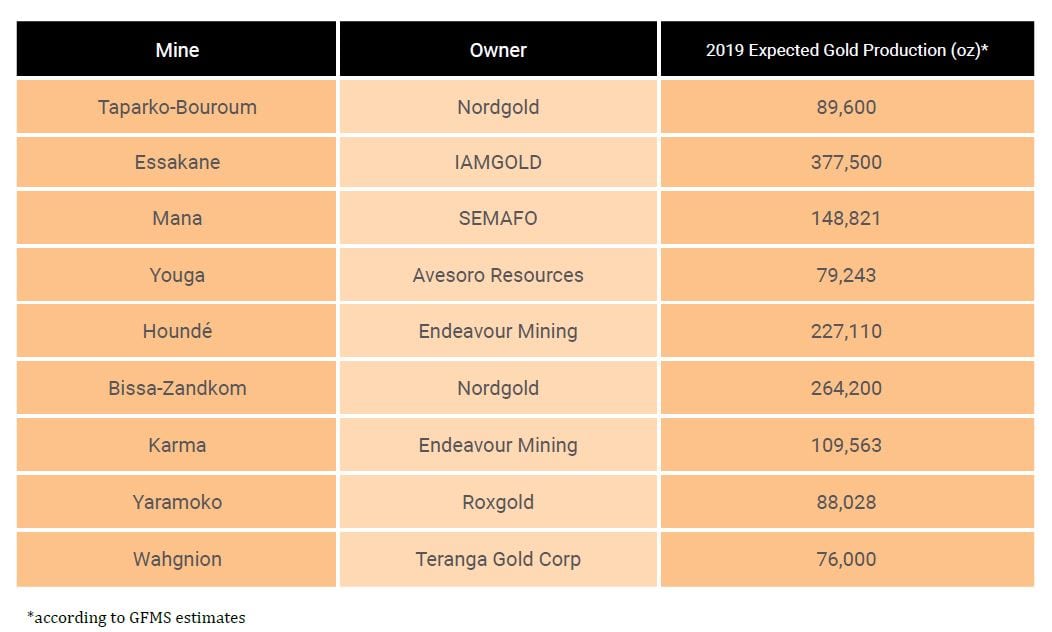
Despite security issues and production delay at the Youga gold mine owned by Avesoro Resources following a fatal incident on site in August 2019, one of the insiders decided there was an opportunity to privatize and offered to take out Avesoro at premium, equal to USD 43.26 per total resources ounce.
While there is always a chance that terrorist activities could spread within the country, at present terrorism is more of a regional issue. The government understands the importance of revenue generated from gold mining activities and thus, security measures at the bigger mines, as well as areas that contain clusters of gold mines and deposits, should be of a higher standard and kept safer from terrorism attacks.
Burkina Faso is already an important gold producer in Africa, and it still has even more to offer. Despite the threats to other companies, Teranga Gold’s (for full profile, please see here) Wahgnion came online in August 2019, ahead of schedule. Wahgnion is the second producing mine for Teranga, who acquired this project (along with others) through the takeover of Gryphon Minerals in 2016, for USD 19.35 per total resource ounce. Wahgnion (previously known as Banfora) holds total resources of 4 million ounces, and is expected to produce an average of 114 koz annually once the production reaches commercial status, at an AISC of USD 904/oz and a mine life of 13 years. According to the technical report, the estimated after-tax IRR of the project only yields 12.7 percent, but the estimated gold price used was a conservative USD 1,250. Thus, the economics of Wahgnion should have improved, as such a project is highly leveraged to the gold price.
While the GFMS predict that gold production in Burkina Faso could fall further in 2020, it is worth highlighting that the exploration potential, as well as M&A potential, remains high in the country. For example, IAMGOLD (TSX: IMG), the owner of Burkina Faso’s largest gold mine, Essakane, has been the subject of takeover rumors in recent months. Furthermore, the Houndé belt is one of only two locations in Burkina Faso known to have Tarkwaian sediments, a well-known trap rock for mineralization in West Africa. The volcano-sedimentary units that make up the belt wrap around the nose of a large intrusive to the west, which could be a source of mineralized fluids, and straddle one of two main structural breaks in Burkina Faso which could act as the conduit for the fluids. The combination of a potential fluid source, a conduit, and a trap makes this area highly prospective for economic concentrations of gold mineralization. The Houndé mine, the Yaramoko mine, and the Mana mine are all located on this belt.
Stimulating M&A Interest
Also located on the Houndé belt is Sarama Resources (TSX-V: SWA), an interesting small junior company. I was initially a shareholder of Sarama, but decided to sell out all the shares after they farmed out up to 75 percent project interest in their flagship project to Acacia Mining (LSE:ACA). in 2014, for a combination of cash payment and working commitments amounting to USD 15 million. At that time, the South Houndé project held 1.5 million gold ounces in total resources. In 2016, the management of Acacia Mining even compared the southern Houndé belt to Western Australia’s Eastern Goldfields greenstone belt in terms of potential. However after spending USD 13 million in South Houndé, Acacia decided to transfer the ownership rights back to Sarama for a combination of USD 2 million cash to be paid in four stages, production-based payments, and share warrants. Not a bad deal for Sarama after all.
According to my conversation with Sarama’s CEO Andrew Dinning in 2019, Dinning thinks the Bondi deposit has the highest exploration potential within the company’s pipeline. The Bondi deposit, which Sarama purchased from Orezone Gold in 2016, lies within the Djarkadougou property of the ThreeBee Project, and has a historical resource of over 400 koz. The deposit is high grade (some drill holes encountered 20g/t Au), with high quality ROM feed expected at grades of 2.5-3.0 g/t Au, free milling with recoveries of 97 percent in oxides, and 91 percent in fresh, and is open in several directions.
Adjacent to the South Houndé project is Teranga Gold’s Golden Hill deposit. Teranga acquired 51 percent of the Golden Hill project interest through the takeout of Gryphon Minerals in 2016. In less than two years, Golden Hill has produced a series of high-grade, near-surface drill results. In October 2018, Teranga paid AUD 10 million to its project partner to acquire the remaining project interests of Golden Hill and Gourma. Earlier in 2019, Teranga estimated the project’s total resource to be slightly more than 1 million ounces, at an average grade of 1.81 g/t Au. Teranga then announced a 27,000-meter drilling and exploration program at Golden Hill for the second half of the year.
There could be a positive synergy between Golden Hill and Sarama’s ThreeBee Project, as the two projects are relatively close and may possibly share some infrastructures.
Sarama’s Bondi deposit is approximately 20km-30km
away from Golden Hill
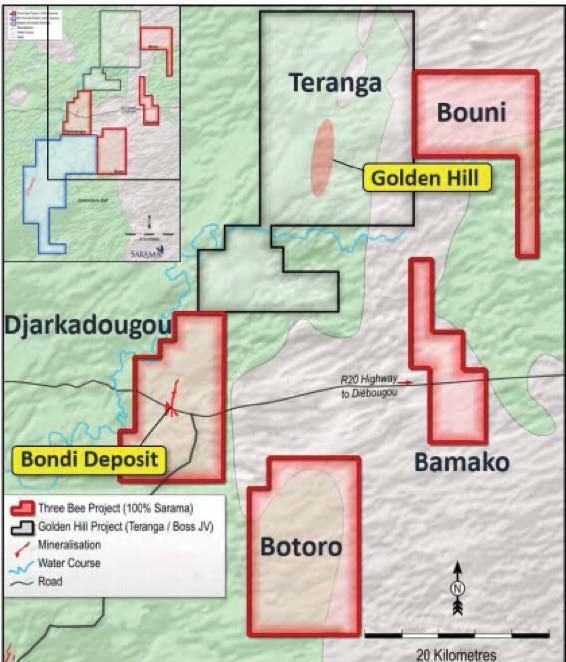
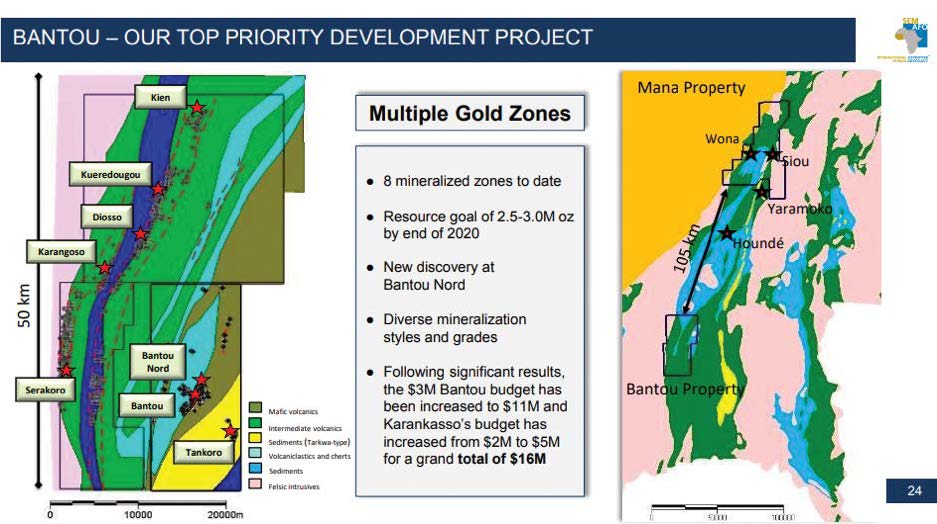
Expanding Resources in Bantou
In April 2019, SEMAFO (TSX: SMF) completed a transaction to acquire Savary Gold in a CAD 22.7 million shares acquisition deal. The deal represented a 100 percent premium to Savary’s share price before the announcement, and indicated a USD 38.3/oz of total resources. Savary operates the Karankasso gold project, which holds an inferred resource of 805,000 ounces, and is located right next to SEMAFO’s Bantou project. Combining Savary’s Karankasso with SEMAFO’s Bantou property produced a 1,250 km² district scale land package on the prolific Houndé greenstone belt.
SEMAFO now owns 78 percent of Karankasso, while Sarama owns 22 percent. While Bantou currently only holds 1.1 million ounces of total resources (at an average of 5.35 g/t Au), it’s telling that SEMAFO decided to bump up development and drilling cost at Bantou from CAD 3 million to 11 million, and budget on Karankasso from CAD 2 million to 5 million, for a grand total of CAD 16 million within the 1,250 km² district and next to Sarama’s South Houndé. SEMAFO’s goal is to secure Bantou’s total resources to 2.5-3.0 million ounces by the end of this year.
On initial thought, it made perfect sense for Sarama and Savary to join forces and become a bigger entity. That was until SEMAFO decided that taking over the latter was worth a shot. As of writing, Sarama is offering less than USD 6 per total resource ounce (compared to the USD 38.3/oz SEMAFO was willing to offer Savary). With two projects that are lying close to other projects owned by majors, and both Silver Lake Resources (ASX: SLR) and Orezone Gold (TSX-V: ORE) as shareholders, Sarama is probably one of the only companies currently offering the most value as well as M&A opportunities in the entire gold mining industry. However, sometimes offering great value in the market is not always a good thing, because it means management has failed in persuading the market to offer the company a fairer valuation.
Other Gold Opportunities in Burkina Faso
Looking at the central area of Burkina Faso, Bomboré is probably one of the largest oxide gold deposits in the country, with over 6 million ounces of total resources at an average grade of 0.68 g/t Au. The deposit is a combination of oxide and sulfide, which will need different recovering methods. According to its latest feasibility study, Bomboré is expected to have an average annual production of 133.8k oz in the first 10 years. At a discount rate of 5 percent and a base case gold price of USD 1,300/oz, the after-tax net present value of the project comes to USD 361 million (compared to USD 153 million initial capex targeting the oxide materials, USD 63.2 million as expansion capex targeting the sulfide materials, and USD 66.2 as sustaining capex). It will also have an IRR of 43.8 percent, and AISC of USD 730 per ounce, and a 2.5 year payback.
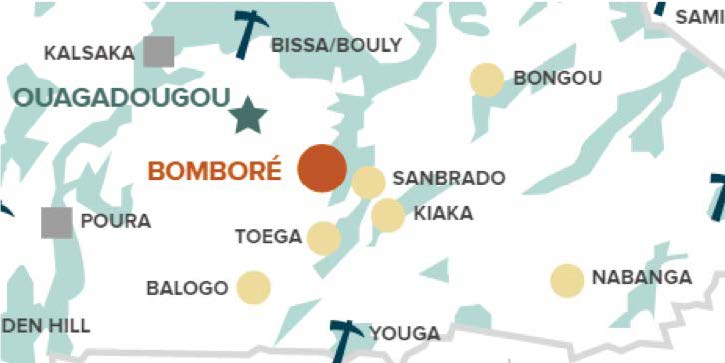
However, there is further potential in the economics of the Bomboré project, outside of the fluctuation of the gold price. Regional exploration drilling in 2017 and 2018 continued to intercept oxide mineralization in several zones outside of the current mining model, and the latest sulfide test work provided better results than previous test work recoveries that has not been included in the 2019 feasibility study.
The valuation of Orezone is cheap, indicating a USD 20 per total resource ounce. The first gold pour is planned for mid-2021.
Within approximately 15km distance from Bomboré, there are other two gold deposits – Sanbrado (3.1 million ounces of total resources at an average grade of 1.74 g/t Au) owned by West African Resources, and Kiaka/Toega (7.0 million ounces of total resources at an average grade of 1.07 g/t Au) owned by B2 Gold. (TSX: B2 Gold)
Sanbrado is already fully funded and fully permitted, and is scheduled for mid-2020 production. It is a combination of high-grade underground and open-pit operation, and conventional 2.2 Mtpa SABC CIL plant. The mine plan has Sanbrado’s average annual gold production at 153 koz over 10 years, and the AISC of USD 650 per ounce throughout the life of the mine. At 5 percent discount, Sanbrado offers an after-tax net present value of USD 444 million and an IRR of 62.1 percent, against an initial capex of USD 186 million. At USD 1,200 gold price, the post-tax payback period is only estimated to be 14 months. As a result, while the valuation on West African Resources is far higher than its Burkina Faso peers, it is backed up by the potential of this high-margin operation.
On the other hand, B2 Gold has been slowing down its exploration efforts at Kiaka/Toega complex, seeing its exploration budget dropping from USD 5.2 million in the first half of 2018 to USD 3.1 million in the first half of 2019. In 2017, B2 Gold already determined that the Kiaka deposit would require higher gold prices or nearby exploration success to become economically viable. However, does the chance of a commercial production improve if the Kiaka/Toega complex combines its operation with its nearby deposits?
Two high-grade hits were made at Diabatou, north of Golden Rim’s Kouri 1.4m oz deposit
Looking at exploration companies in Burkina Faso (beyond SEMAFO’s Bantou project), there is a junior that has been releasing eye-popping drill assays. Golden Rim Resources(ASX:GMR), an explorer that already has a 1.4 million ounces of resource at an average grade of 1.4 g/t Au at its flagship Kouri project, acquired an extension of land package to the Kouri project and conducted its first drill earlier last year. Two shallow high-grade gold lodes were discovered at Diabatou, approximately 10 km northeast of the Kouri deposit; MRC008, from 41m, encounters 7m at 121.2 g/t Au, including 1m at 783.8 g/t Au; MR014, from 67m, encounters 4m at 23.2 g/t Au, including 1m at 65.7 g/t Au. Hole MR014 is approximately 25m northwest and parallel to hole MRC008, and the second hit of the bonanza gold did offer some assurances to the speculators that this may be more than just an one-hole wonder. These high-grade gold intersections are hosted in fresh granite at shallow depth, and mineralization is open at depth and along strike.
Golden Rim plans to follow up with a 14,000 meter drilling program which will include infill drilling in the existing resource area, as well as extension drills. It is expected to announce an updated resource in the next few months.
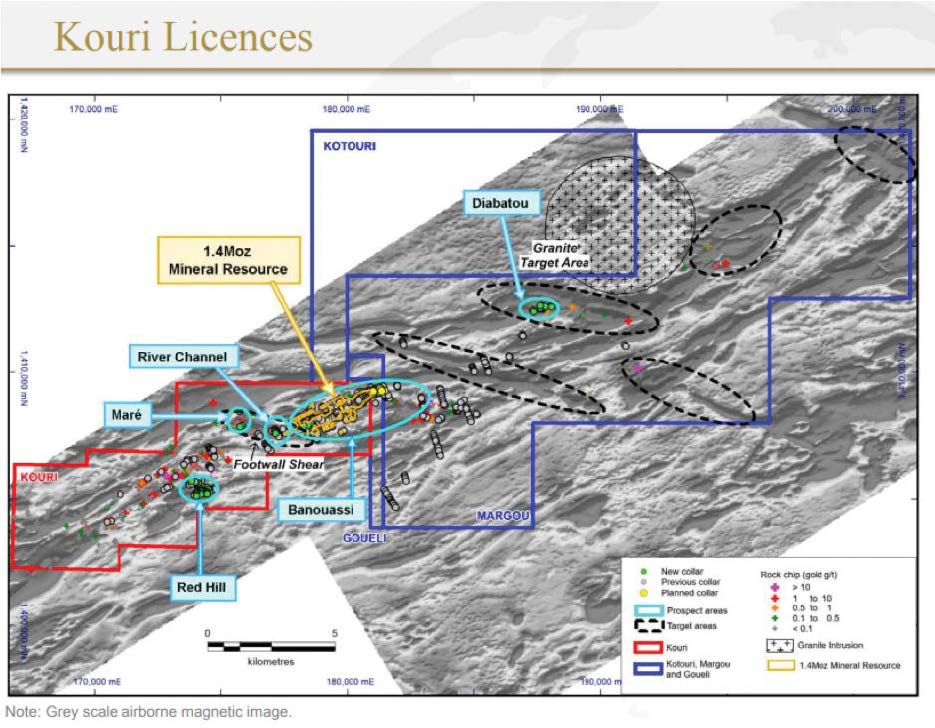
The corporate action of another ASX-listed junior has also raised some eyebrows. While Australian gold projects have been market darlings in recent years as the Australian gold price continues to hit historical highs, Arrow Minerals (ASX: AMD) worked against the bulk of the trend by putting their Western Australia gold project on the back burner and acquiring a portfolio of gold projects in Burkina Faso. To cope with the change of the corporate direction, Arrow Minerals restructured its management, including the appointment of Howard Golden as Chief Executive Officer, and Tommy McKeith and Mr Morgan Ball as Non-Executive Directors, all of whom have various working experience in Africa.
In December last year, Arrow Minerals confirmed a significant near-surface gold discovery at the Divole West gold project featuring an intersection of 33 meters at 1.9g/t gold in their first drill hole.
Acquisition Valuation in Burkina Faso
The chart at the top of this page (FIG1) shows the companies who have taken up projects in Burkina Faso in recent years, and the respective acquisition costs in terms of implied value per total resource ounce.
The weighted-average acquisition cost was an average of USD 30.46 per ounce in the example above. Obviously each deposit and project is unique, and it is not the quantity but quality of the ounces that determines the acquisition cost. The gold price at the time also makes a difference. Nevertheless this is only a rough barometer of what one can expect on the valuations of future acquisitions in Burkina Faso. To put this valuation into context, the weighted average of gold M&A acquisitions in 2019 was USD 76.67/oz.

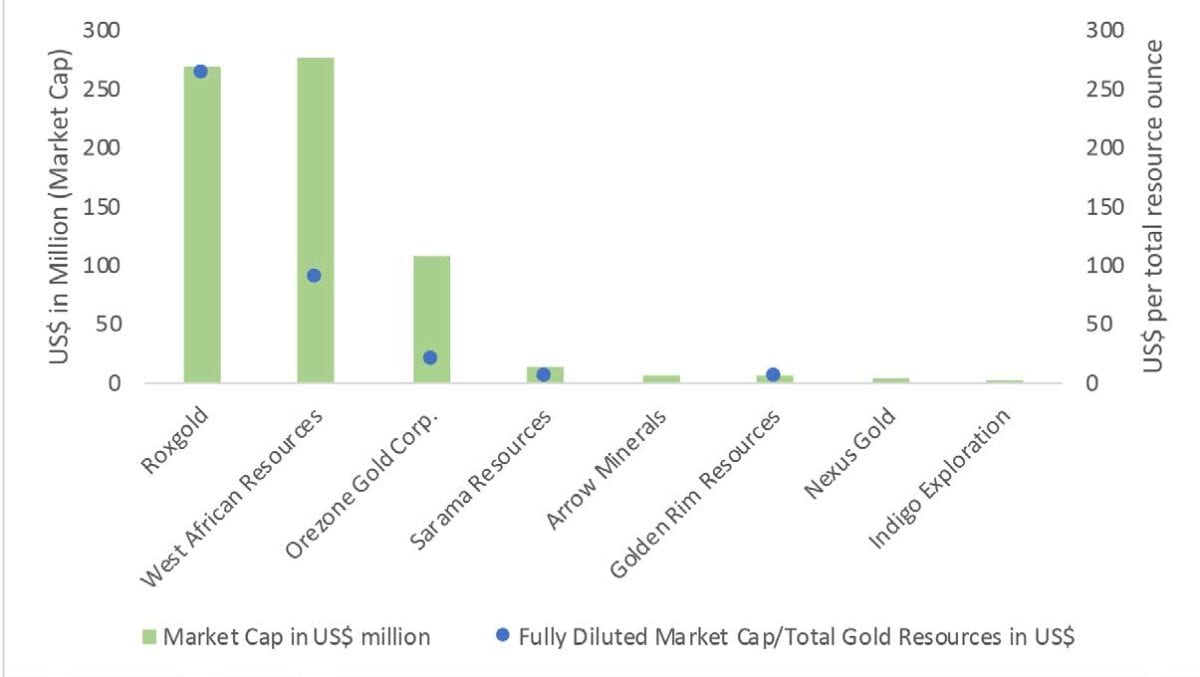
Valuation of Roxgold and West African Resources (ASX: WAF) stick out among Burkina Faso plays, due to the quality of their respective projects and the fact that the market is willing to pay more for quality. Valuation on Orezone, Sarama, and Golden Rim are at the other end of the spectrum; they could be massively undervalued when compared to the whole gold mining industry. According to RBC Capital Markets, valuations of gold exploration companies were sitting at an average of USD 56/oz in 2019. The valuation of many current Burkina Faso plays are also still below the average of the historical acquisition ounce of USD 30.46. While the cheap valuation may suggests there are speculative upsides, the management of these companies also need to take steps to instill more public confidence into their projects and the investment value of the listing vehicles.
Burkina Faso’s Potential in Mining
While the Western investment community may feel that Africa in general is a high-risk jurisdiction, there are certainly groups that are not afraid of getting into the continent, such as Chinese mining companies. The Chinese government has passed various policies in the last few years that make mining even more challenging for many local businesses. As a result, many Chinese companies have incentives to look for projects overseas. With the recent surge of the gold price, Chinese mining companies are more enthusiastic about acquiring overseas ounces, especially in emerging countries like Africa and South America.
The icing on the cake (that is, the interest they already have) is that they usually pay cash upon acquisition. More importantly, they are still not familiar with the mining industry in Burkina Faso, as it only re-established diplomatic relations with China in May 2018. Thus, there’s a lot of potential for the Burkina Faso government to attract Chinese capital into the country if they play their cards right. Strengthening the country’s security measure is a good start.
Despite Burkina Faso remaining under the threat of terrorist attacks, it may still be a better place for mining (as long as it’s a regional rather than country-wide problem) than many of its African peers, where royalties and taxes have been hiked in recent times. When a country’s gold production has been increasing by a compound rate of 23.1 percent in the last decade, the government must be have been doing something right.
Moreover, as the general market may not bother conducting proper due diligence (in finding out that the recent violence has been more of a regional problem than a country-wide problem), projects with good potential may still be hit by cheap valuation due to the bias in ‘Burkina Faso risk’ – even if the location of the project is deemed to be safe. Those who conduct their proper due diligence may be rewarded handsomely if they manage to separate market noise from facts.


